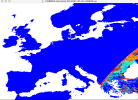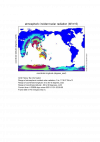Dear All,
I am experiencing some issue in running continental-scale simulations (approx. 6km resolution) across Europe (see attached plots). In particular, I am getting a weird pattern of the stomata resistance (both SHA and SUN components) during the sunrise and the sunset, with night-day switch across the domain. It seems that there is mismatch between the internally calculated solar zenith angle and the timing of the radiation forcing. Any feedback will be much appreciated. Thank you in advance!
Best,
Mauro
I am experiencing some issue in running continental-scale simulations (approx. 6km resolution) across Europe (see attached plots). In particular, I am getting a weird pattern of the stomata resistance (both SHA and SUN components) during the sunrise and the sunset, with night-day switch across the domain. It seems that there is mismatch between the internally calculated solar zenith angle and the timing of the radiation forcing. Any feedback will be much appreciated. Thank you in advance!
Best,
Mauro





